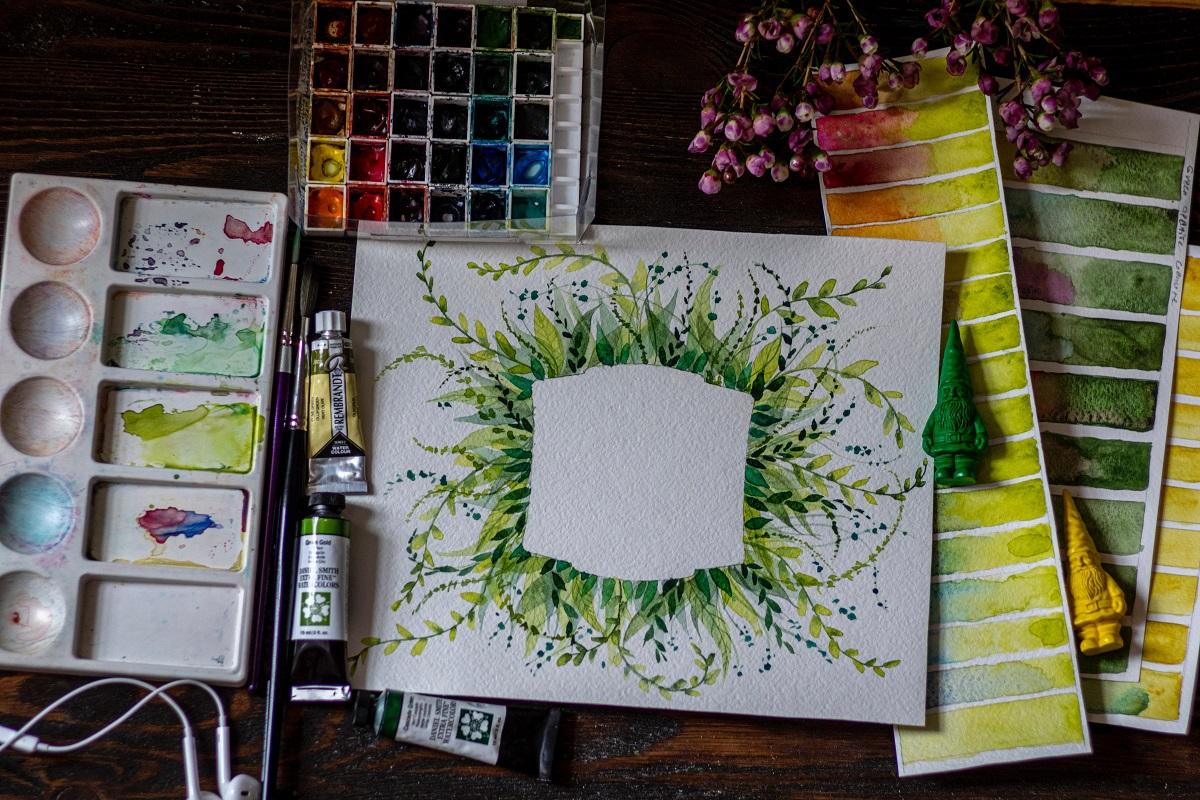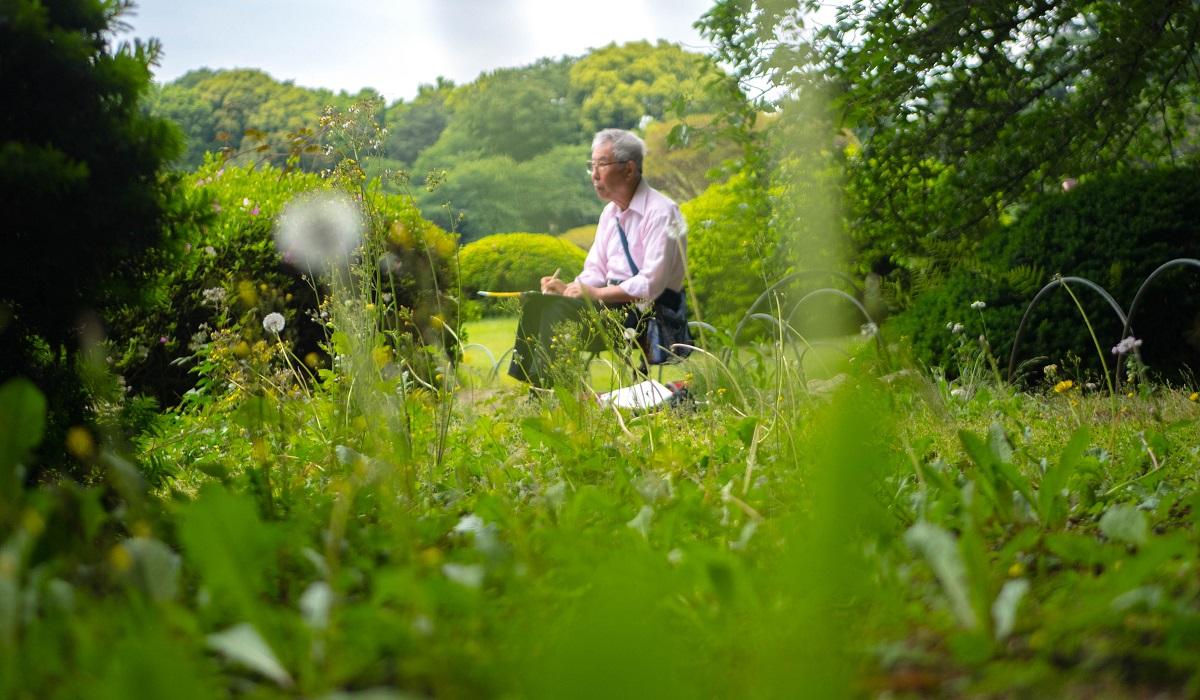When recreating landscapes on a canvas, painting grass lawns or meadows the right way can make all the difference.

But this is an area where amateur artists often struggle, as they can’t always recreate the different intricacies of a clump of grass accurately, even if they use the best professional watercolor paints. Plus, there are several other important considerations, such as the shades to use, the variations to create based on the type of landscape, what to paint in watercolor landscapes, compostion, etc.
If you aren’t fully aware of such details, the quality of the painting might fall short of your expectations. That’s why we thought of compiling this guide on how to paint grass with watercolors to know about painting grass with watercolors, this will work with watercolor paints In tubes sets as well as watercolor pans.
Let’s start painting!
How To Paint Grass With Watercolors

Characteristics To Consider While Painting Grass
To draw or paint anything, it’s essential to observe it and identify some features that will guide your art. Here are the features of grass that you’ll need to take into account:
1. Lines
While painting grass, the first thing to consider is the type of lines you’ll have to draw. Make sure to draw lines that are thicker at the lower portion and narrower towards the top.
2. Direction Of The Strokes
All grass doesn’t grow in the same direction; some might be shorter, damaged, or bent.
3. Color
You should try to add subtle color variations through different brush strokes instead of using just one shade of green, a mistake that beginners tend to make.
The Color Scheme
Though grass can be other colors, like yellow or red, artists paint them green for the majority of their creations.
But they often combine several other colors with green so that the painted grass resembles real grass as closely as possible. The most widely used color scheme for painting grass of different shades is as follows:
- Lighter shade: lemon yellow + permanent light green
- Darker shade: Prussian Blue + Emerald Green
- Add a tinge of umber to get a brown shade
At the start, make sure you have the light green, dark green, and umber paints ready for use. You will need two round brushes for the job — one of size 8 and the other of size ½.
Painting Grass With Watercolors - The Technique
The wet-on-wet method is the simplest and most widely used option for painting grass and requires pre-wetting the lower portion of the canvas lightly beforehand. It can be useful both for painting simple scenes, such as long grass clumps growing near a lake, or more detailed landscapes, like an expansive meadow surrounding a farmhouse.
The steps to follow for the purpose are described below:
Step 1
Firstly, dab the light green color along the lower part of the painting to create the base. Then draw dense vertical brushstrokes a little towards the top that resemble the typical shape of grass blades. Keep in mind that you won’t need to go into the details at this stage.
Step 2
Next, dab the dark green shade with the help of the brush point. But you shouldn’t cover up the first paint layer completely — remember when we talked about the importance of adding variations to the color? You’ll need to blend the colors in such a way that slightly darker grass blades are visible among the lighter blades.
Step 3
At this point, you should switch to the smaller brush. Paint thin linear strokes using the lighter green shade initially, then switch to the darker shade later. Also, the lines should tilt in different directions and be of varying lengths.
Step 4
After you’ve painted the vertical strokes, the grass will seem as though it’s floating. To make it look like it’s growing from the soil, softly dab light and dark green shades towards the bottom. This will help combine the dark and light green colors while the paint is damp.
Step 5
You can follow this by adding grass flowers on the top. It just requires painting dots around the tip of some grass blades.
Step 6
Proceed to paint the soil by dabbing the burnt umber paint softly and blending it at the lower portion.
Step 7
Now, you’ll have to enhance the depth of the grass by combining a little bit of burnt umber with dark green. Paint short vertical lines at the lower portion for this purpose.
Some Basic Tips To Follow While Painting Grass
In place of the above method, you can also apply some fundamental theories and ideas for painting grass in different types of landscapes:
1. Apply Directional Brushwork
A simple yet effective method is to use brushwork that matches the movement and form of the grass. In case you want the grass to point upward, use upward brushwork. Likewise, if a strong wind is blowing the grass to your left, work the brush in a similar way.
Legendary artists like Vincent Van Gogh used vertical, strong brushwork to draw grass on a calm day, creating a strong stylized effect.
Alternatively, you can adopt a subtler approach with such brushwork, keeping the strokes vertical at the low portion of the sketch and flattening them over a distance. Then the painting might offer a better perspective.
2. Utilizing Underpainting Or Stained Canvas
Some artists deliberately begin their paintings by staining the canvas using an earthly, dull tone such as burnt sienna, yellow ochre, or raw umber. Such a strategy provides them with the alternative to leave portions of the stained canvas more exposed in the final painting. It’s especially useful for painting different types of grass since the earth tone of the canvas mimics plants, rocks, dirt, etc.
3. Identifying Some Basic Shapes
The challenge of painting grass lies in the details it provides to the painting, that is, the different colors, highlights, shadows, lines, etc. You can overcome this difficulty by simplifying the grass down to some abstract and basic shapes. That way, you can recreate the form and structure of the grass in a better way.
The best examples of such art pieces are those where the grass is painted using the basic tones of dark and light. Remember that such artwork lacks finer details.
4. Applying Broken Color
The term broken color is given to the method of building up a number of colors in different layers on a canvas, which makes the lower layers exposed. Such a technique generally involves painting the canvas with small color dabs until it’s filled.
When it comes to painting grass, this method lets you create the illusion of numbers without having to draw every grass strand separately. The great French artist Claude Monet had mastered this technique and used distinct color strokes that seemed like plants, rocks, grass, etc., in his paintings.
On a side note, applying broken color doesn’t mean you have to use several hues every time. You could also use a limited range of hues but create variations through their saturation. Thus, the green color could be made of several tones, such as dark, dull, and light greens.
5. Use Points Of Interest
Another useful strategy is the application of flat color planes and the addition of small points of interest on the top. For example, in the Cremorne Pastoral watercolor painting by Arthur Streeton, the artist has depicted flowers, small plants, rocks, etc., that provide context and direct attention to the painting. Note that this technique can also wonderfully spruce up an otherwise bland area.
6. Identifying Important Portions
While painting grass, you won’t require drawing each grass strand, as identifying and focusing on some important areas can be much more effective. For example, many famous artists have used remarkable details for the foreground in their landscape paintings but have kept it simple when painting the bushes in the background.
7. Utilizing The Physical Texture Of The Paint
Apply the physical texture of the colors to mimic the grass texture you want to paint. You can build up thick and textured paints to create a rough foreground.
This technique can be especially effective when it’s combined with certain contrasting strategies like:
- Thick hues for highlights and thinner alternatives for shadows
- Thick hues in the foreground and thinner paints in the background
- Thick hues for warmer shades and thin paints for the cooler ones
While using thicker paint, the small marks formed by the bristles of the brush can depict individual grass strands. But this will be more effective when created with brushes having firm bristles rather than those with weak and thin bristles.
Things to Consider While Using Watercolors
Now that you know about the nitty-gritty of painting grass, we’ll touch upon some basic precautions to take while using watercolors for the purpose:
- Buy specialized paper watercolor
- Plan the colors beforehand
- Keep the pencil sketch light
- Protect the lightest areas
- Allow the layers to dry
- Clean the brush between colors
- Replace the water regularly
Paint Grass With Watercolors Frequently Asked Questions ?
What other colors can you use to prepare a grass green color?
To mix light greens, you can apply light blue hues like Cerulean Blue and a light yellow like Cadmium Yellow. The resultant color can also be made lighter using Titanium White.
As for the darker shades, you will need to combine a gray shade, such as Paynes Gray, with the above mixture of yellow and blue. Notably, Paynes Gray is a mixture of black and blue.
In case you wish to make it warmer, use equal proportions of Paynes Gray and New Gamboge in the mixture.
Does the color of grass vary with the location and the season?
Yes, both the texture and color of grass will vary with the location and season. While young shoots are green during early spring, long grass that’s scorched by the sun takes a light brown or ochre shade. So, keep in mind that the grass in a painting depicting a spring scene shall be different from that in a fall landscape.
Another point worth noting is that you should use strong colors as accents in the foreground instead of creating flat color blocks; otherwise, the grass might look artificial.
Can a fan brush be of any help in painting grasses?
Firstly, know that fan brushes have thin bristles spread out by a ferrule. They are particularly useful for blending colors, so you can apply them while painting grasses using the wet-on-wet technique.

Paint Grass With Watercolors Final Words
We hope you enjoyed this colorful journey through the world of landscape paintings. So, gather the right paints and brushes, and let the magic unfold on your canvas!
Before we call it a day, here’s another tip for you: to create a unique texture when drawing grass, add some kosher salt just after you’ve painted it. Keep in mind that you’ll need quite a bit of paint to create the desired effect, as it would then mix with the salt to produce the necessary texture.
See you next time!
